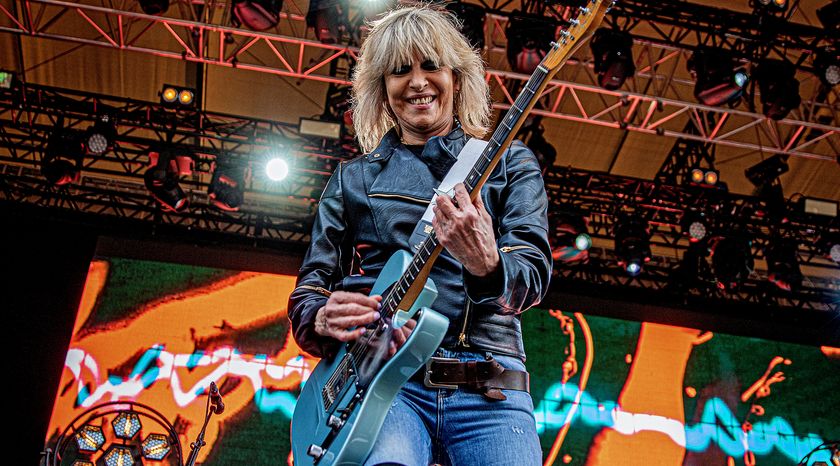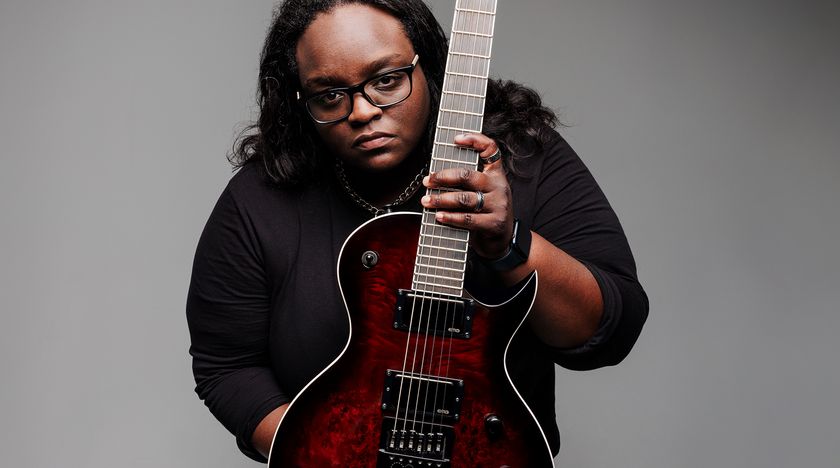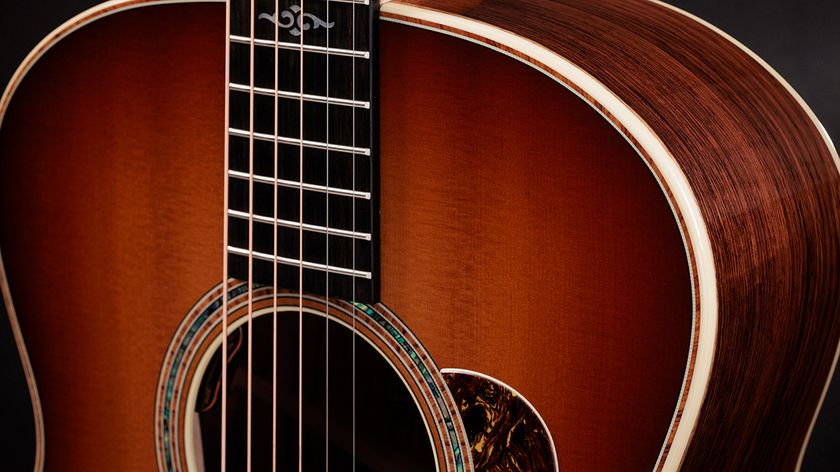GuitarPlayer Verdict
Featuring a high-quality XMAX-L solid-state microphone preamp and phantom power the diminutive AudioBox GO is a great lightweight travel companion.
Pros
- +
Light & portable
- +
Great sound
- +
Phantom power
- +
No AC adaptor needed
Cons
- -
Low, but sufficient, headphone output
You can trust Guitar Player.
Like many musicians, I’ve made an iPad a critical piece of my music gear.
I travel quite a bit, so I rely on it to collect my musical thoughts for songwriting and arrangements, and I’ve learned that you don’t need a high-powered DAW to make music while you’re on the go.
In most cases, even GarageBand for the iPad can get the job done, but relying on the tablet’s built-in microphone, while useful for some situations, can be limiting.
So I was happy to see PreSonus engineers had figured out a lightweight and ultra-compact design for a mobile 2x2 audio interface, and I couldn’t wait to check it out.
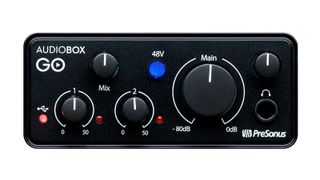
The new PreSonus AudioBox GO is USB powered, so there’s no power supply to plug in. It offers two inputs: one combo input for XLR or ¼-inch TS line inputs, and one ¼-inch TS input for instrument.
Front-panel controls allow you to set levels and mix the two inputs with the aid of two LED clipping indicators.
There are ¼-inch TRS jacks for the left and right main outputs, to send signals off to powered speakers, but the ¼-inch TRS stereo headphone out was appealing to me for monitoring and playback while on the road.
I also appreciated that the unit can supply phantom power for condenser mics.
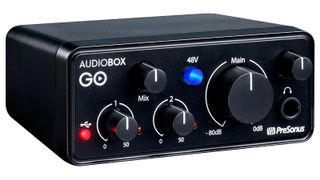
We all have different needs, and the three features of the AudioBox GO that stood out for me were the high-quality XMAX-L solid-state microphone preamp, the phantom power, and the unit’s light and compact design.
I explored each of these features in a pre-production session while away from my home studio.
My plan was to work out a rhythm-section arrangement in GarageBand for an upcoming session. I’d set up the song using one of the GarageBand drummers, then add guitar, bass, and a reference vocal track with the help of the AudioBox GO.
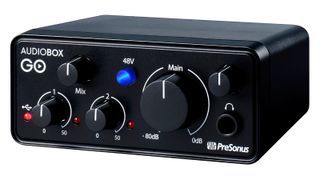
First and most important to me was the quality I would get from this portable interface. I wasn’t planning to make any final recordings in my hotel room, but I wanted the best possible sound, since I’d be distributing these tracks to other players.
First and most important to me was the quality I would get from this portable interface
And while I was happy that the company’s XMAX-L preamp was one of the core components, I was also concerned about how the PreSonus engineers would have handled implementing this well-known and good-sounding preamp using only the power provided by a USB 3.0 via a USB bus connection.
While I can typically get more headphone output from an AC-powered audio interface, the levels on the AudioBox GO were sufficient to make a recording, and the quality was very good.
I tried two popular CAD condenser microphones (one large diaphragm for vocals and one cardioid instrument mic) and was able to record solid and clean tracks with sufficient headroom.

The unit’s size and weight were equally impressive. The AudioBox GO has a plastic case with rounded edges for easy storage in a bag or pouch, and it seems sturdy enough, though you’ll want to install the little rubber feet provided to keep the lightweight unit from sliding around on the table.
Knobs for the two inputs, mix, main out and headphone level protrude from the face, but they seem solid, are nicely spaced and work smoothly.
The only indicators on the unit are LEDs that indicate USB connection and clipping on the channels, plus a 48-volt phantom power button that glows blue – a nice feature to remind you that power is being applied to a microphone.
The unit comes with PreSonus’s own Studio One Prime DAW software
And, if you had any doubts about the little AudioBox GO being professionally designed, it works with the free PreSonus Universal Control app, which allows users to update firmware and make adjustments to sample rate (44.1, 48, 88.2 or 96 kHz) and block size for optimal performance.
The AudioBox GO manual explains how to set up popular audio applications, but the unit comes with PreSonus’s own Studio One Prime DAW software, which you can download free once you register your purchase at presonus.com.
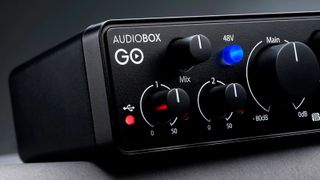
The unit works with macOS 10.13 or later and Windows 10 or later, with additional details about using it with Chrome OS, iOS/iPadOS, and Android available at presonus.com.
All in all, I found the diminutive AudioBox GO a great lightweight travel companion, one that would pack away easily and free me from having to use the built-in iPad microphone when a track called for the use of a condenser microphone or direct input.
Nicely done!
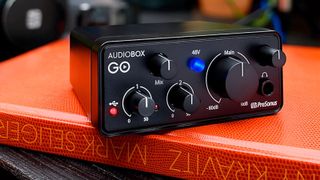
Specifications:
- INPUTS: 1 x XLR-1/4” mic/line combo, 1 x instrument line input
- PHANTOM POWER: Yes (48v)
- OUTPUTS: ¼-inch TRS main, ¼-inch TRS stereo headphone
- CONTROLS: Input levels for channels 1 and 2, mix, main and headphone output levels
- INDICATORS: Clipping LED for channels 1 and 2, 48v power on/off
- FREQUENCY RESPONSE: 20 Hz to 20 kHz
- RESOLUTION AND SAMPLE RATES: 24-bit at 44.1, 48, 88.2, or 96kHz
- POWER SOURCE: USB-C bus
- DIMENSIONS: 4.25 W x 3.3” D x 1.73 H
- WEIGHT: 0.51 lbs
Visit PreSonus for more information.

“Those people are full of it! If you can hear those nuances, my hat’s off to you!” Joe Bonamassa weighs in on the allure of P90 guitar pickups with Bon Jovi's Phil X
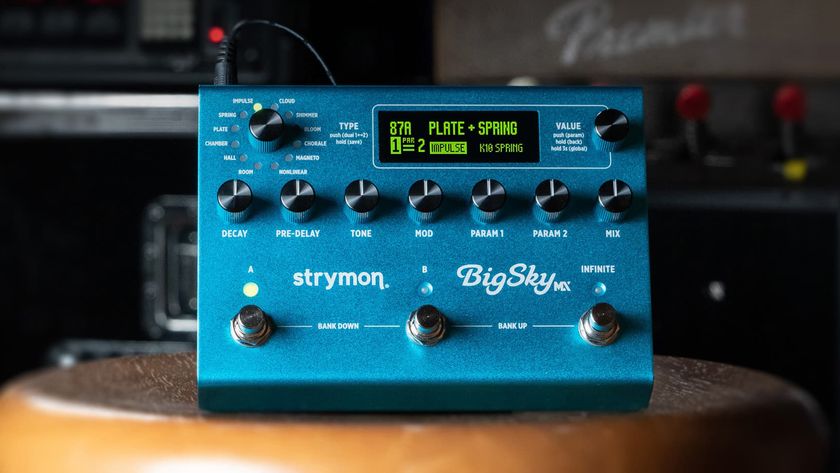
"BigSky MX will be replacing the BigSky as my go-to reverb pedal. I’ve heard nothing that covers all the bases with such pristine and detailed audio quality." We crowned the Strymon BigSky MX the champ of multi-reverb pedals

